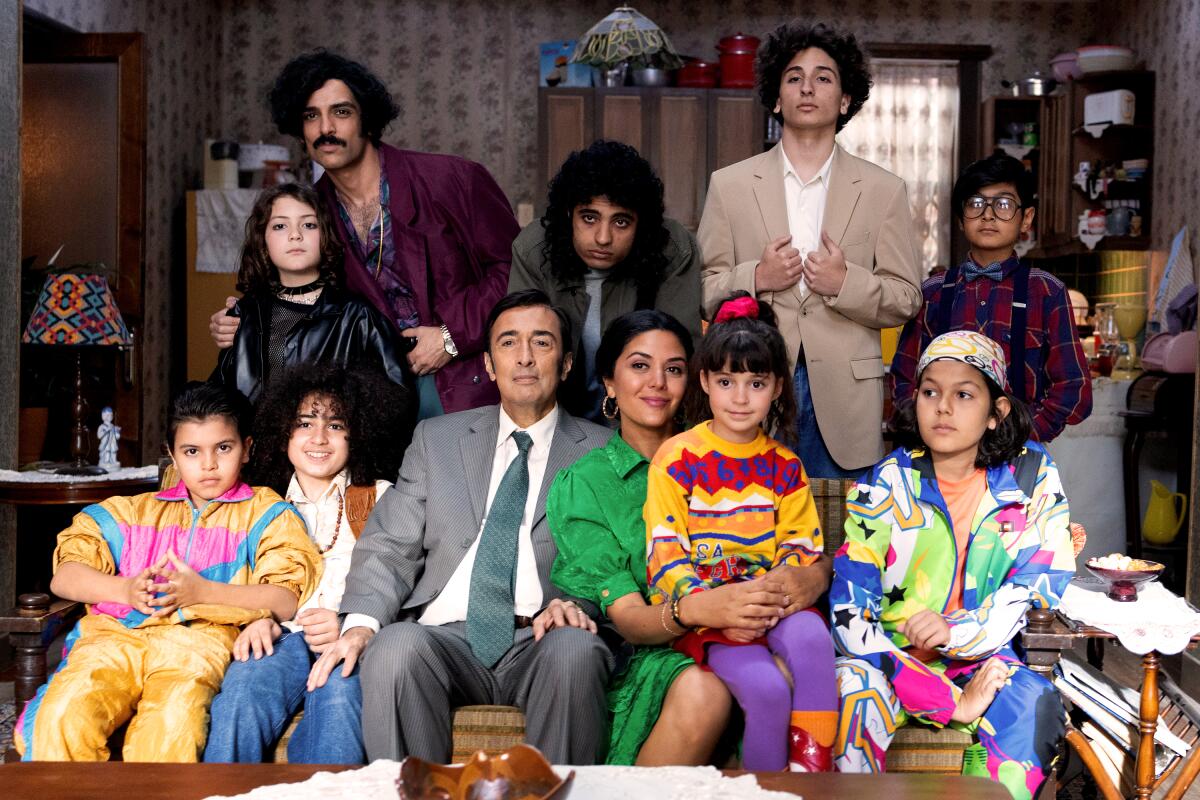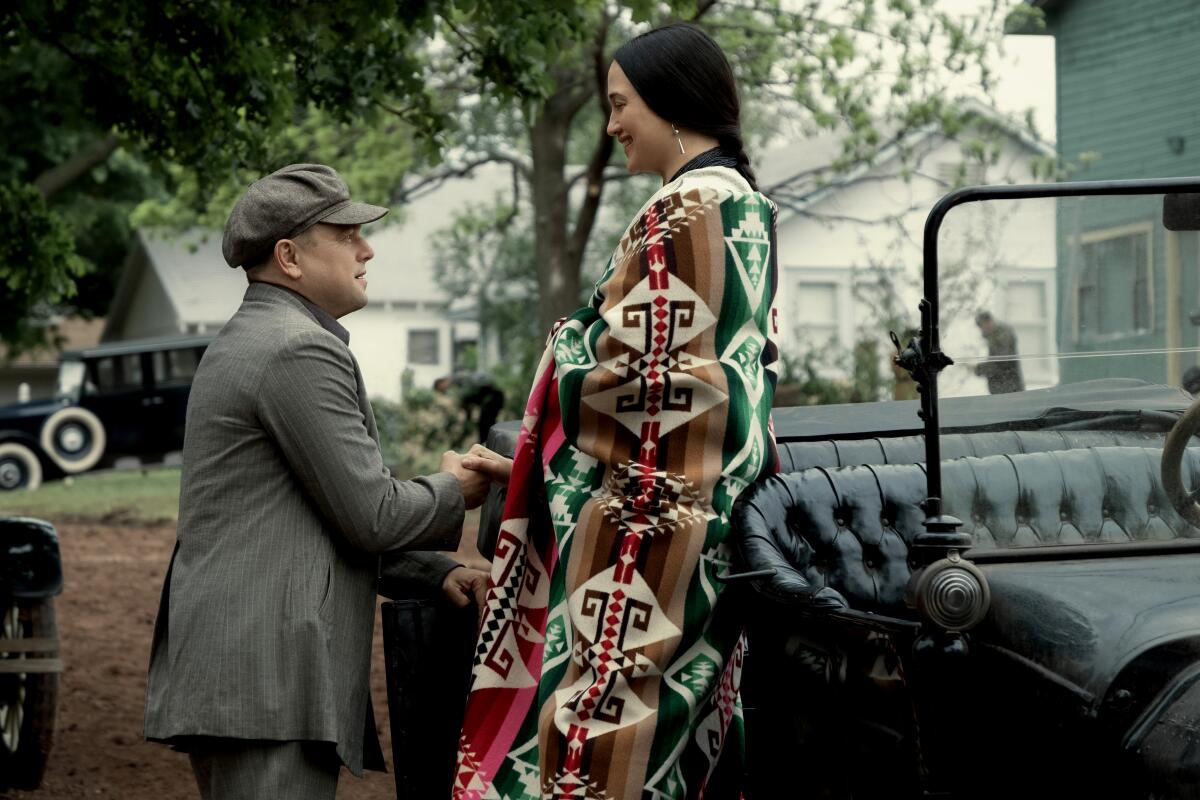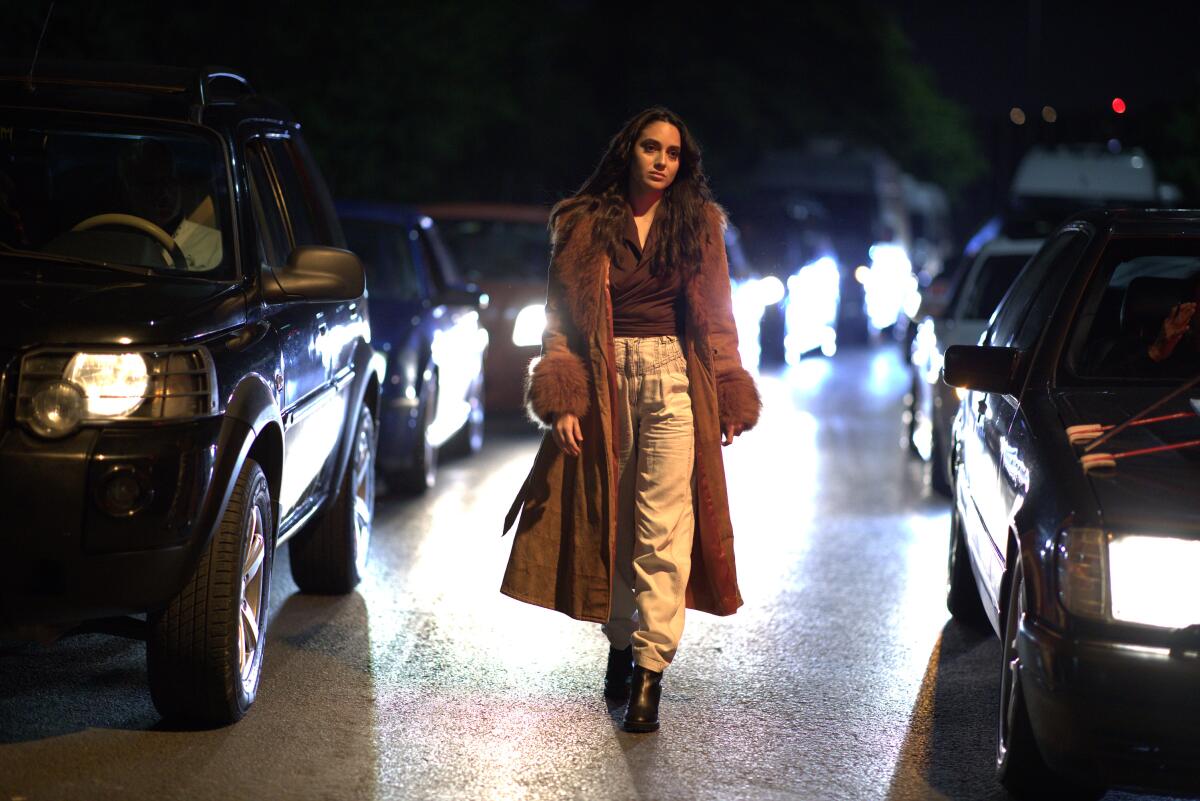The family roller coaster of ‘The Persian Version,’ plus the best movies in L.A.

- Share via
Hello! I’m Mark Olsen. Welcome to another edition of your regular field guide to a world of Only Good Movies.
While this has obviously been a devastatingly difficult time in the world, this newsletter is concerned with movies and moviegoing. Among the bigger stories this week in these parts was the announcement that L.A.’s 101-year-old Egyptian Theatre will reopen on Nov. 9 with a screening of David Fincher’s “The Killer” with the filmmaker in attendance. The Times got an exclusive tour of the restored movie palace in August.
Netflix, which now owns the theater, will also give upcoming runs to Bradley Cooper’s “Maestro” and Wes Anderson’s short films. The American Cinematheque will continue to program the theater on weekends, and will be bringing back its festival of 70mm films to the theater from Nov. 10-21. The full lineup will be announced Tuesday.
‘Killers of the Flower Moon’

Since its premiere at the Cannes Film Festival, Martin Scorsese’s adaptation of the nonfiction book “Killers of the Flower Moon” has been one of the most anticipated and discussed movies of the year. It’s electrifying to see a filmmaker of Scorsese’s age and stature make a picture that burns this hot in examining its own POV, grappling with the complexities and limits of its own perspective.
Set in Oklahoma in the 1920s, the film follows a white man, Ernest Burkhart (Leonardo DiCaprio), who marries an Osage woman, Mollie Kyle (Lily Gladstone), who is wealthy from oil money. Ernest’s uncle, William Hale (Robert De Niro), is a local businessman deeply involved in exploiting the Osage people for as much of their money as he can in a variety of nefarious ways, and Ernest and Mollie are very much a part of his orbit.
In his review of the film, Justin Chang wrote, “Even if we reject the usual art-deadening canards about who is and isn’t allowed to tell whose story, it’s worth noting that one of the film’s most poignant and surprising scenes finds Scorsese himself addressing that very question. With wit and humility, he implicates himself in a vast storytelling tradition — one that encompasses radio and theater as well as cinema — that has continually exploited, marginalized and glossed over images and narratives of Native American life. That humility is crucial, and moving in its own right. Whatever its triumphs and missteps, revelations and blind spots, ‘Killers of the Flower Moon’ comes by them all honestly. It has been made in rightful hope that the American crime epic, a genre Scorsese has pushed to peerless heights, can still open an audience window into a richer understanding of culture and history.”
Carlos Aguilar spoke to Mexican-born cinematographer Rodrigo Prieto, who, besides working on “Killers,” also shot Greta Gerwig’s “Barbie.” The new film is the fifth collaboration between Scorsese and Prieto. Asked to describe their work together, Scorsese said, “Nothing stops him. Not the extreme heat in Oklahoma when we were shooting ‘Killers,’ not the typhoons in Taiwan on ‘Silence.’ Nothing.”
Breaking the rules with ‘The Persian Version’

Written and directed by Maryam Keshavarz, “The Persian Version” won the screenplay prize and the audience award when it premiered earlier this year at Sundance. Loosely autobiographical — “It’s a little bit more than semi,” Keshavarz said during a Q&A following a recent screening of the film — the story follows Leila (Layla Mohammadi), an Iranian American woman who unexpectedly becomes pregnant, causing her to reconcile with her mother, Shireen (Niousha Noor), and discover a deeply held family secret.
In our review by Katie Walsh, she writes, “That [Keshavarz] manages to deftly juggle multiple timelines spanning two countries, flashbacks, medical emergencies, ironic fourth wall-breaking and a couple of dance breaks is impressive, because despite the breakneck pace, it’s not hard to keep track of everything.”
Keshavarz uses an incredibly free storytelling style, setting aside the main story for digressions, direct address and the odd dance number. The director has been teaching filmmaking at her alma mater, New York University, admits that the structural freedom of the movie is “all the things I tell my students don’t ever do.”
“I’ve written a lot of scripts in my career,” Keshavarz said, “so I feel I have a deep understanding of structure. And all of these rules in the end are meant to be broken. You have to follow the best way to tell the story. I knew I wanted to break the fourth wall because there’s so much to explain. And I wanted to be playful because I thought you had to have a little bit of context of this world of Iran in America.”
Keshavarz has ended up with a bustling, busy comedy loaded with incident. “It’s an hour and 47 minutes and it takes place over four decades,” she said. “So it’s a lot in there. But more than anything else, I wanted to make it fun. It’s like: Come on to the roller coaster of my family.”
In particular, the long digression to tell the back story of Leila’s mother feels like it breaks the momentum of the main story, but actually deepens and enriches it, so the film’s finale becomes much more powerful.
“It was important to me that you don’t really like the mother in the beginning and by the end you’re crying for her,” said Keshavarz. “I wanted to disarm the audience. And the point is that we should find a way to be empathetic with each other. We should find a way, even in the same family. You might not have the same belief as me, but you’re family. You have to love each other. You have to find that way.”
In making her version of a coming-of-age story, Keshavarz has brought to the screen an experience she says she has not often seen, the feeling of being torn between two lands and two cultures.
“For me it’s simply the thing I wanted to see as a kid,” Keshavarz said. “I grew up in a very Iranian family in New York and all of our friends are Persian. I learned to be American watching American TV shows and American films. But I never felt anything reflected our culture. I would watch Scorsese or Spike Lee, but this was a chance to show the truth of who we are. Iran is so diverse but this is my family. To show the joy, the love, the music. I think we’re not so different than anyone else.”
Other points of interest
‘We Are Coming’ at Vidiots Presented in collaboration with the Autry Museum of the American West, Vidiots will turn over its marquee this weekend to artists Yumi Janairo Roth and Emmanuel David for the traveling installation “We Are Coming,” acknowledging the long-forgotten names of the Filipino Rough Riders from Buffalo Bill’s Wild West shows. To continue the celebration of Filipino American History Month, on Sunday there will be a screening of Martika Ramirez Escobar’s 2002 film “Leonor Will Never Die,” along with Shireen Seno’s 2014 short “Shotgun Tuding.”
Jen Yamato spoke to Escobar last year for “Leonor,” about an aging filmmaker who wakes up inside her own unfinished screenplay. “Every time I see my grandma, she tends to redeem my disappointment in life,” Escobar said. “I think that’s mainly the reason why I decided to have a grandma action star. She seems to find so much beauty in this sick, sad world, and I’d like to attain that wisdom someday.”
‘May’ at Whammy Whammy Analog Media will screen Lucky McKee’s delightfully inventive 2002 horror film “May” on Saturday. An awkward young woman named May (Angela Bettis), who has only a childhood doll for a best friend, struggles to forge meaningful relationships with people. Eventually she gives the idea of “making a friend” a new meaning. The film has a romantic lyricism and a sense of strangeness that makes its portrait of loneliness something original. And the film was edited in part by Rian Johnson before he made his feature debut as a director with “Brick” a few years later. Steve Yedlin, who would go on to shoot all of Johnson’s features, is cinematographer here as well. The Whammy screening is being presented by Briana Gonzalez of the horror zine Brain Rot, who recently wrote, “‘May’ is the perfect movie for weird, lonely, misunderstood girls everywhere.”
‘The Untouchables’ This newsletter is reflexively pro-Brian De Palma, so news that the Academy Museum is showing a new 35 mm print of his 1987 film “The Untouchables” will not go unnoticed. Kevin Costner plays federal agent Eliot Ness attempting to take down mobster Al Capone, played by Robert De Niro. The screenplay was written by David Mamet. A masterclass in sheer pop-cinema perfection, the film was nominated for four Academy Awards, including one for Ennio Morricone’s score, with Sean Connery winning for supporting actor.
In her decidedly mixed original Times review, Shiela Benson wrote, “To Mamet and De Palma, goodness and dullness seem inseparable. … It’s strange that in this somber inspection of moral fiber and what causes it to fray, De Palma couldn’t have made his hero at least as interesting as his villain, and both of them at least as complicated as they were in life.”
At the time, Deborah Caulfield spoke to the film’s producer Art Linson once the film had become a success. As he said, “When you make a movie that’s a hit, everybody says, ‘Of course — you have David Mamet, De Palma, De Niro, Connery. This was a walk in the park.’ Well, it wasn’t.”
‘Nocturama’ The Academy Museum will also be screening Bertrand Bonello’s dazzling, disturbing “Nocturama” on Sunday. The film depicts a cadre of young wanna-be revolutionaries who carry out a bombing plot around Paris and then hide out in a closed shopping center, losing themselves amid the consumer culture they intended to rebel against. The film bears a relationship to such recent films as “Monos,” “Night Moves” and “How to Blow Up a Pipeline,” as well as Jean-Luc Godard’s classic “La Chinoise.”
I spoke to Bonello ahead of the film’s international premiere at the 2016 Toronto International Film Festival, where he said, “Now, the world is much more complex and there’s a lot of ambiguity. For me, I really hope that in the film, the ambiguity you see is a reflection of the ambiguity of the world around us.”
Only good movies
Get the Indie Focus newsletter, Mark Olsen's weekly guide to the world of cinema.
You may occasionally receive promotional content from the Los Angeles Times.




